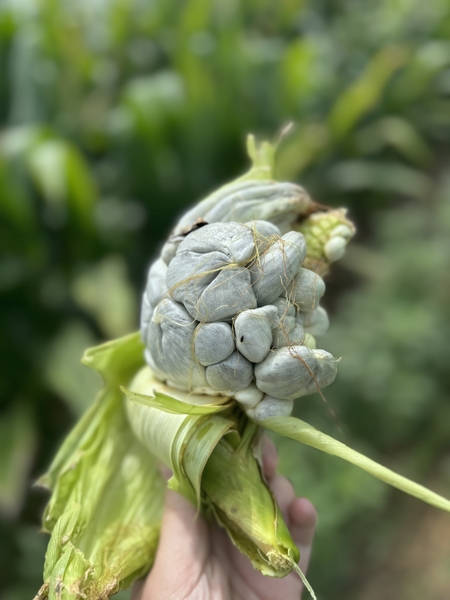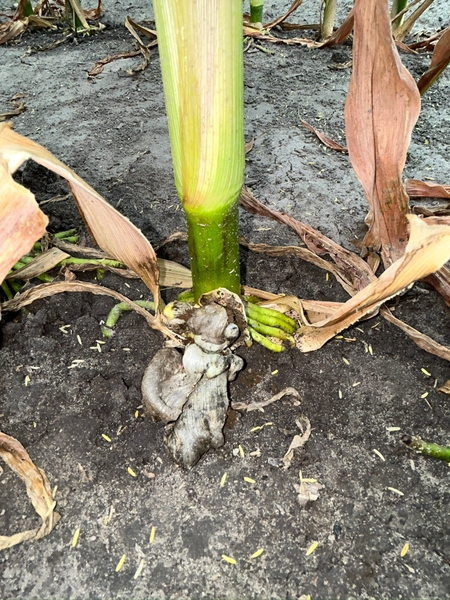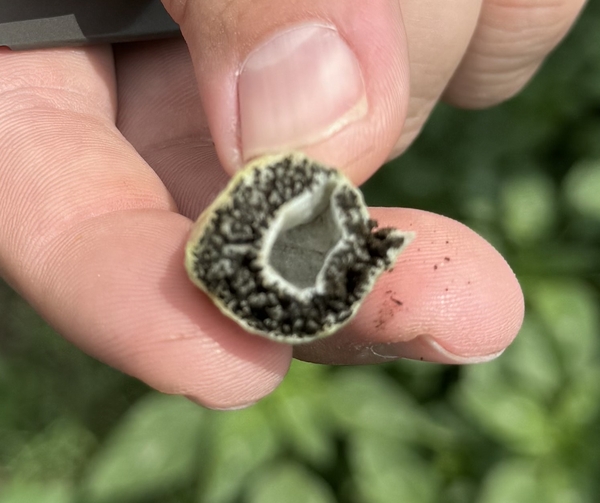Pathogen
Common smut is caused by the fungus, Ustilago maydis.
Symptoms
Common smut causes yellowing of green tissue and the production of light green or white to gray, fleshy galls on any part of the corn plant, including leaves, tassels, stalks (Figure 1) and ears (Figure 2). Symptoms are more likely to occur on tissue that has been damaged by equipment, animals, insects, and wind. On leaves and tassels, gall sizes will be limited in size (0.2 inches). On stalks and ears, galls can grow up to 6 inches and cause economic losses. Pollinated ovaries are less susceptible to smut, so smut is more likely to occur first at the tip of ears, which is pollinated last. Galls are filled with black, powdery teliospores (Figure 3) that are released when the galls rupture. Infections remain local to where the spores land and germinate.
Disease Cycle
Ustilago maydis teliospores overwinter in the soil and are spread through equipment, insects, wind, and rain. Spores will germinate in humid, warm (75-95°F) temperatures to produce basidiospores that fuse to produce infectious hyphae, which directly penetrate into host tissue. Galls form within a week after infection and enlarge for up to 3 weeks before the gall mature, dry, and rupture. Teliospores can survive for 5-7 years, depending on cultural and environmental conditions.
Disease Management
Crop Debris Destruction
- Destroy all stalks and other debris from fields, as soon after harvest as possible. Till debris as deep into the soil as possible, while managing soil erosion.
Crop Rotation
-
Common smut is limited to corn, in nature, so crop rotation with any other crop is effective at reducing disease pressure.
-
The longer the crop rotation, the more beneficial the rotation is at lowering the disease pressure.
-
A 3 year crop rotation is more beneficial than a 2 year rotation, though a 2 year rotation is more beneficial than no rotation.
-
Resistant Varieties
- There are no corn varieties resistant to common smut, though you may consult with local seed representatives to discuss hybrid options
Planting and Growing season
-
Reduce drought stress through irrigation
-
Ovaries that fail to pollinate sufficiently are more susceptible to common smut
-
-
Reduce nutrient stress through proper fertilization
-
Corn grown under high nitrogen levels or treated with high rates of manure are more susceptible to common smut
-
-
Scout for smut galls and remove galls before they rupture
-
Teliospores in galls overwinter into the following season
-
Chemical Control
-
Scout for insects and manage insect damage by using insecticides at optimal times.
-
Common smut is more common when tissue is injured.
-
It's Edible!
In Mexico, cuitlacoche (or huitlacoche) is the name for common smut galls. People in some cultures, especially in Mexico, cultivate, sell, and eat immature galls as a delicacy. While the galls are safe to eat, avoid feeding the ungalled (asymptomatic) kernels of infected corn (corn with galls) to livestock, as they may contain high levels of mycotoxins produced by ear rot fungi.
Publication date: July 24, 2024
N.C. Cooperative Extension prohibits discrimination and harassment regardless of age, color, disability, family and marital status, gender identity, national origin, political beliefs, race, religion, sex (including pregnancy), sexual orientation and veteran status.
Recommendations for the use of agricultural chemicals are included in this publication as a convenience to the reader. The use of brand names and any mention or listing of commercial products or services in this publication does not imply endorsement by NC State University or N.C. A&T State University nor discrimination against similar products or services not mentioned. Individuals who use agricultural chemicals are responsible for ensuring that the intended use complies with current regulations and conforms to the product label. Be sure to obtain current information about usage regulations and examine a current product label before applying any chemical. For assistance, contact your local N.C. Cooperative Extension county center.
N.C. Cooperative Extension prohibits discrimination and harassment regardless of age, color, disability, family and marital status, gender identity, national origin, political beliefs, race, religion, sex (including pregnancy), sexual orientation and veteran status.



